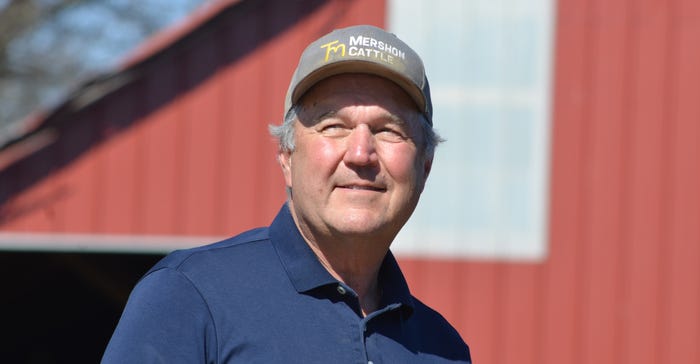With cows in 13 counties, one beef producer increased his cow herd through strategic relationships.

Walking to the bed of his farm truck and grabbing a bag of mineral, Bruce Mershon talks of rising input costs in cattle production. Cows gather around as his calm voice brings them to the feeder. He empties the bag and shares how cow-calf producers finally got ahead in terms of price only to have expenses chip away at profitability.
From the outside, this even-keel approach to the cattle business would never let on that Mershon is actually a risk taker. The new Missouri Cattlemen’s Association president spent his entire career dealing with what he calls “uncontrollables” as a commodity trader.
When he retired in 2018, most in the business would relax and steer clear of opportunities that involve risk. But the Jackson County farmer loves farming, so his retirement plan is raising and finishing cattle in Missouri.
Making time to farm
Mershon still farms the family land outside of Buckner. While a commodity trader for nearly three decades in nearby Kansas City, Mo., the proximity allowed him to return to the farm, work and plan for the future.
“We realized that the one thing that probably won’t change in Missouri is that we will always have fescue somewhere in the state and an abundance of it,” he says. “So, we decided to expand our cow herd.”
Mershon started with about 150 commercial Angus-based cows bred to Hereford, Simmental and Charolais sires. Today, he and his wife, Tracey, have 2,000 momma cows, but they are not all in one location.
The couple have cows strewn across 13 counties along much of the western region of the state from Gentry County in the north down to Dade County in the south. It is part of a unique business approach to raising cattle he calls “Pasture Partners.”
Growing relationships
They first dabbled in this aspect of paying to place cows on other farms in 2001 because they did not have the forage or land space to increase the cow herd on the family farm. But the venture quickly ramped up, and currently there are 15 Pasture Partners.
Farmer demographic varies in the program. “We have a retired gentleman that just runs heifers,” Mershon explains. “He wants to run them in the winter because he cuts fescue seed in the summer.”
His voice quickens when talking about the opportunities for the next generation. “We have young producers that are just starting out. They're working off the farm but want to run cows, but they've bought a farm or leased a farm. Typically, they get money for the cows or the land, but they can’t get both. Pasture Partners allows them to not have that capital requirement of the cows.”
Mershon says working with these younger producers is rewarding. “I really like developing those relationships. As they continue to grow, we grow with them.”
Grass management also differs from farm to farm. Mershon encourages rotational grazing or intensive grass management because “our cattle perform better.” However, it is not a requirement.
“We have partners who have two or three pastures, and it is what it is,” he says. Ultimately, Mershon is looking for Pasture Partners who offer quality forage and care for his cattle. The goal is to provide sound calves for the family’s feedyard.
Feeding calves
In 2016, Mershon built a hoop structure with the intent of buying high-risk calves from the sale barn and finishing them. However, that opportunity never evolved like he wanted, so he switched gears, and now the building is used to calve out heifers.
Cows calve in both fall and spring as Mershon tries to take advantage of all the equipment twice a year and all the bulls twice a year. “Missouri is great because it allows us to do that,” he says.
He finishes all home-raised calves in open-air dry feedyards, but still buys calves from Missouri sale barns to fill the lots. The farm also has a backgrounding operation where about 4,000 stockers are fed out annually.
Most of the finished calves head to Iowa, Nebraska or Kansas for harvesting. However, Mershon hopes that will change with American Food Groups building a processing plant on the eastern side of the state. “I could see us finishing cattle in Missouri and shipping there, absolutely,” he notes.
“The stocker portion and the feeding portion is a margin business,” Mershon explains. “If we can make some margins there, then our focus can be on the cows and growing a herd with superior commercial genetics. We’re not trying to just have cows. We’re trying to have really, really good cows.”
Room to expand
“I think our Pasture Partners model will grow,” he says. “I think people are going to go to that model because why can’t I own 10,000 cows or 20,000 cows with the right genetics?”
His goal is to find the right cross to make a cow that is adaptable to fescue, successfully rebreeds and efficiently produces calves that yield high Choice or Prime carcass. It is a tall task, but Mershon is up for it.
“I didn’t get to farm for 33 years,” Mershon says, “I’m just excited about the challenge to see what I can accomplish. I guess that is the entrepreneur and risk taker in me.”
President's priorities
Bruce Mershon outlines some of his priorities for this year as the new Missouri Cattlemen’s Association president.
Education. “What I'm focusing on is how can we make our Missouri producers better cattle producers,” he says. “How can we educate them on better soil health and grazing? Our producers could run twice as many cows in the state of Missouri, with better grazing management.”
Mershon says cattle producers need more education like grazing schools, information on capturing carbon credits, and how to use cost-share programs. “Those who take advantage of these types of opportunities can help with productivity,” he notes. “They are the ones that are going to survive in the business.”
Emerging leaders. Mershon’s personal goal is developing new leadership for the association. That includes training those newly elected to leadership positions and encouraging the next generation of cattle producers to engage with Missouri Cattlemen’s Association.
“If I’ve done my job right, MCA will be better off after I’m gone,” he explains. “I want the next leaders to have even more success. The goal is to keep developing those new leaders, and we will all prosper down the road.”
About the Author(s)
You May Also Like





